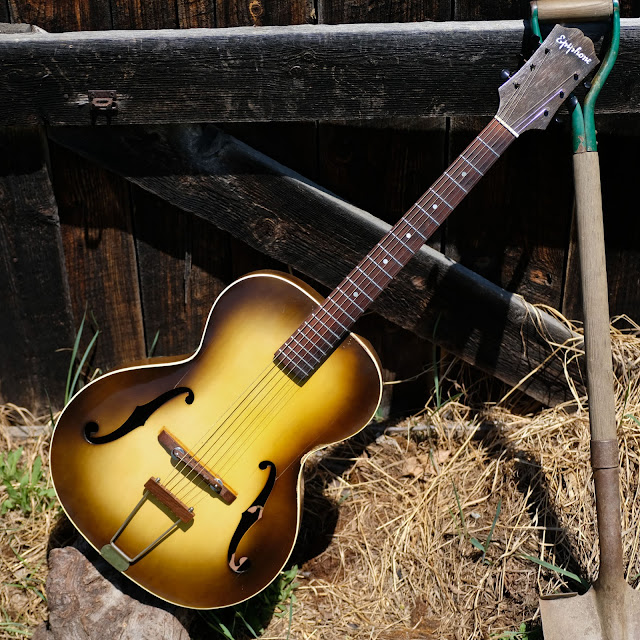1943 Epiphone Olympic Carved-Top Archtop Guitar
I've had a swarm of poplar-topped, wartime Epiphones in via consignors lately. I had another '43 Olympic just back in late March! This one is rip-roaring, loud, and has that beautiful velvet, chunky sound to it. It's a great backup-chorder (as well as a jumpy lead/melody machine) and has the bizarre, green-yellow-brown sunburst that Epis manage to pull-off so well. Its 19470 serial checks-out as '43 per the NY Epi Registry.
Work included a fret level/dress, minor compensation at the bridge, cleaning, and cleats for a few hairline cracks on the top. It's now playing spot-on, has a straight neck (and a functional truss rod), and is good to go. I'm fairly sure that the frets are replacements from some point in time, too. The endpin is also replaced as the original tailpiece seems to have lost its bottom point on its mounting-plate side, but is otherwise all there. It's, of course, missing its original pickguard -- though having the original bridge and wartime rosewood string-retainer-trapeze is pretty nice. Binding is all good except for a little boogered-up spot right next to where the pickguard would've been mounted on its bracket.
Specs are: 25 1/2" scale, 1 5/8" nut width, 1 1/4" string spacing at the nut, 2 1/8" spacing at the bridge, 15 1/2" lower bout width, 11" upper bout, and 3 3/8" side depth at the endblock. The neck has a ~10-12" radius on the fretboard and a mild-to-medium soft, C/V back profile. It's a fast player! Action is 3/32" EA and 1/16" DGBE at the 12th fret with room to adjust the bridge up/down how you like. Strings are 54w-12s in 80/20 at the moment.
Because of wartime shortages, this has a carved poplar top instead of spruce. The back and sides look like a curious ply mahogany (maybe?) while the neck seems to be two-piece-with-center-strip maple. The neck may have an overspray job on its rear but I'm not sure. Otherwise, the finish is definitely all-original.
It's hard to see the cracks in the bright sun, but there's a hairline running to the upper bout from the top of the treble-side f-hole and there's one doing the same from the bass f-hole. It's hard to see them on the inside but they were open enough from the outside that someone wicked glue into them in the past. I added cleats and they're stable and good to go. There's also a very, tiny hairline at the bottom (lower-bout-side) of the treble f-hole, too, and it's cleated as well.
The ebonized headstock veneer has just the right amount of wear-n-tear. The nut is original and bone and the inlay is pearl.
The radiused board is rosewood and has pearl dots.
Truss rod access is under the fretboard extension.
Note the discolored area on the top in front of the bridge -- that's presumably from someone trying to glue the bridge down in the past.
I love the look of the rosewood hanger on these wartime Epis.
These are pretty bog-standard Kluson openback tuners from the time and they're working just fine.
A funky-but-functional chip case comes with it.



















Comments